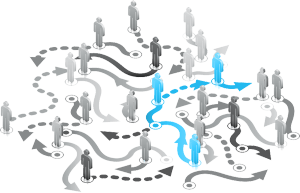 The year may not feel that “new” anymore, but it’s not too late to vow to take better care of ourselves in cyberspace. Here are my thoughts on the commitments people should make (and keep!), not just in 2015 but every year.
The year may not feel that “new” anymore, but it’s not too late to vow to take better care of ourselves in cyberspace. Here are my thoughts on the commitments people should make (and keep!), not just in 2015 but every year.
Sticking with these digital resolutions won’t be easy – I can personally attest to that – but they are important enough to justify the effort required. Among other things, they require resisting the temptation to always take the easiest path, pushing ourselves out of our comfort zones, divorcing ourselves from less productive and effective activities, and establishing the discipline needed to break old habits and create new ones.
To increase the likelihood of success, you should create a plan of action that reflects a crawl-walk-run approach, defines activities in the most specific terms possible, and incorporates a concrete timeframe for each activity. A task like “delete three unused digital accounts in March” is far less intimidating and more manageable than “purge all unused digital accounts.” It’s okay if it takes you a long time to get everything done. Every little bit helps, and every action taken is a step in the right direction.
Depending on your comfort level and degree of technological expertise, you may want to consider getting professional help from a digital adviser who can offer both strategic and tactical insights and guidance. If you would hire an adviser to help you with decisions and actions regarding legal, financial, tax, estate planning and other complex issues, you should be willing to make a comparable investment when it comes to managing your digital affairs. In this day and age, they are no less important. In fact, given how integral digital technology is to managing both our personal and professional lives, one could argue that they’re moreimportant.
Determine a Digital Strategy/Plan for the Rest of the Year
It’s worth reminding ourselves that technology is a means to an end, not an end unto itself. Although there’s been a fair bit of mania regarding social and digital technology over the past five to ten years, we’ve reached a level of maturity that no longer involves jumping on bandwagons or leveraging technology just for the sake of using it. That said, establishing a presence and engaging digitally has moved from being a first mover or early adopter strategy to becoming basic table stakes for both individual professionals and organizations of all types and sizes.
There is no single strategy or one-size-fits-all approach to digital engagement, which means that each of us has to develop a bespoke strategy and plan that best matches our individual goals and objectives. To do that, we need to answer two questions: What do I/we want to achieve this year (in specific, preferably measurable terms)? and How can social and digital technologies help me/us do that?
After answering those questions, we need to drill down deeper to develop specific actions by answering questions like: Where do I/we need a stronger digital presence? What do I/we need to do more of – and where? What do I/we need to do less of – and where?
The “less” question is critical. We’re all dealing with limited time and mental bandwidth. As we increase our commitments in certain areas, we need to decrease our commitments in other areas. It’s impossible to do it all or have it all, particularly in the infinity of cyberspace, and we have to focus on maximizing our digital investments by engaging in the most efficient and effective ways.
Establish and Maintain a Stronger Digital Footprint
Continuing with the “less is more” theme, strengthening your digital footprint doesn’t mean “make it bigger” – it means make it smarter (i.e., more efficient and effective), which for some of us means shrinking it.
Although well intentioned and appropriate for some professionals (given their goals and objectives), advice like this offered by Jeff Bullas is impractical for most of us. Establishing and maintaining a website or blog, for example, requires a large, ongoing commitment, as does creating and nurturing a digital tribe. But you can create a strong professional brand in cyberspace without putting this kind of pressure on yourself.
Using your strategy/plan as a guide and keeping in mind that quality is more important than quantity, here are some important activities to undertake:
- Determine your primary digital presence (i.e., a website or blog, your LinkedIn profile) and make sure that it completely and accurately reflects your professional identity, unique value, and goals
- Review your public profile on all other social and digital sites to ensure they meet your standards for how you want to present yourself
- Conduct internet searches on yourself and clean up as many questionable/unwanted items (e.g., public info you thought was private) as you can
- Shut down and purge social and digital accounts that are out of date and no longer used
Assuming you won’t want to wait another year before cleaning up your digital footprint, you’ll also want to develop and implement a maintenance plan for periodic reviews and adjustments.
Take Privacy and Cybersecurity Seriously
People often express concerns about privacy and cybersecurity, but few if any of us really understand the risks we face – and in many cases create for ourselves. As something of a digital libertarian, I don’t necessarily care whether and how you expose yourself to risk in cyberspace, as long as you’re making informed choices and/or taking calculated risks. You don’t need to read every privacy policy or the terms and conditions on every website you visit/use, but you should make sure you generally understand how things work, where your risks of exposure are, and your digital rights and responsibilities.
There are also a number of basic and fairly simple steps you can take to protect your privacy as much as possible, including:
- Locking down every social and digital account you want to remain private
- Staying logged out of accounts unless you’re actively using them (this is especially true for Gmail/Google+)
- Not storing login credentials or credit card info on websites
- Thinking carefully before you join a new social media platform, add yourself to an email list, and/or download an app
- Not using work email for personal business
- Turning off GPS on your mobile device if you don’t need it; denying location access for apps and websites whenever possible
- Limit activity via free wi-fi to low-risk activities only (this is also a good cybersecurity measure)
Cybersecurity protections are more complex and extensive, but probably the most important among them is to have unique and hard to hack passwords on every device and account, especially those connected to your finances (yet another reason to reduce your total accounts). Yes, it’s a pain, but having your cash depleted, your credit compromised, your files held for ransom, and/or your identity stolen is far worse. How to Build a Secure Online Presence is a great resource for getting your house in order.
Become More Digitally Literate and Effectively Engaged
Digital literacy is something we all have to varying degrees. Some of us are still digital rookies with steep learning curves to climb, but even digital sophisticates can improve their efficiency and effectiveness at leveraging digital technology. I provide some guidance on how to do this here, and I won’t repeat all my recommendations here except one: We should commit to learning at least one new digital concept or trick each week. I know that seems like a lot, but the key is to keep things simple and manageable. Recently, for example, I streamlined my approach to forwarding articles from my mobile device that I plan to share via the Denovati network. And this week I solidified my understanding of what a distributed denial of service (DDoS) is.
Becoming more digitally literate isn’t just about knowledge and skills – it also involves things like:
- Being smarter about when, where, and how we engage via social and digital channels (particularly relative to more traditional means of communication)
- Ensuring companies that provide digital services and conveniences (e.g., Uber, TaskRabbit, Tinder) have cultures and business practices that meet our ethical standards before we use them
- Employing proper etiquette and abiding by normative expectations and communication best practices (including good grammar!)
- Thinking before we tweet, write, post, share, and send
Take Digital Breaks
Effective digital engagement also requires knowing when to disengage. Sometimes these breaks are short, such as when you’re in a meeting, at dinner with friends, or even just walking down a hallway or on the street. But we need bigger digital breaks too, as Joshua Becker discusses in 7 Important Reasons to Unplug and Find Space. Maybe you can’t immerse yourself in complete digital darkness for an extended period, but everyone can afford some regular digital dimming. When you’re traveling or on vacation, for example, you can:
- Delete non-critical email messages without reading them
- Unsubscribe from email lists and notifications
- Avoid logging in to less important social media accounts
- Turn off push notifications on your mobile device(s)
Your Thoughts?
As always, I welcome your feedback. What questions has this piece raised for you? What would you add to, change, or delete from the digital resolutions I recommend?
The original post, with additional links, can be found on The Denovati Group’s website.
(254)
Report Post







